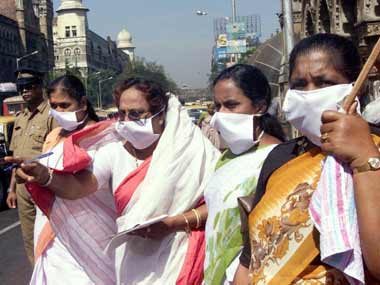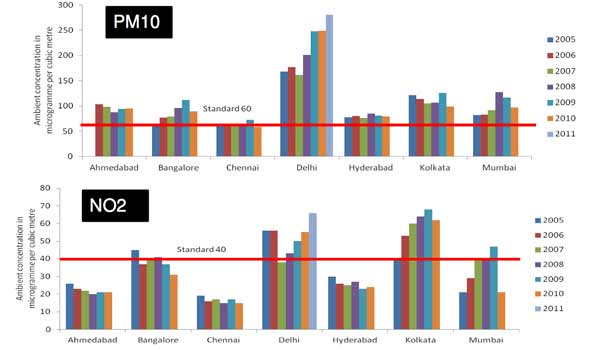Death by breathing: Air pollution killing 620,000 Indians, says report
 New Delhi: The next time you suddenly start wheezing or sneezing and suspect it’s the ice cream you just ate, think again. It may in fact be something as routine as the air you are breathing.
New Delhi: The next time you suddenly start wheezing or sneezing and suspect it’s the ice cream you just ate, think again. It may in fact be something as routine as the air you are breathing.According to the Global Burden of Disease Study 2010, air pollution is now the fifth largest killer in India, after after high blood pressure, indoor air pollution, tobacco smoking, and poor nutrition. The India and South Asia-specific findings of the report were officially released on Wednesday at a Dialogue Workshop jointly organised by Centre for Science and Environment (CSE), Indian Council of Medical Research and the US-based Health Effects Institute.
Out of 180 cities monitored as part of the survey close to half of the total urban population breathes air which exceeds the permissible limits of PM10. The World Health Organisation’s guideline values for PM10 states the annual mean as being 20 micrograms per cubic metre (ug/m3) and the 24-hour mean being 50 ug/m3. Particulate matter smaller than PM2.5 must have an annual mean of 10 ug/m3 and a 24-hour mean of 25 ug/m3.
Anumita Roychowdhury, Centre for Science and Environment’s, head of its air pollution team said, “Days of doubts and complacency are over. There is hard evidence now to act urgently to reduce the public health risks to all, particularly children, elderly, and poor. No one can escape toxic air.”
“This is a shocking and deeply disturbing news. This calls for urgent and aggressive action to protect public health,” said Sunita Narain, director general, CSE, at the discussion.
One third of urban Indians live in polluted areas which have critical levels of PM10 – a number almost as much as Japan’s population of 127.8 million – with cities like Delhi, Mumbai, Ghaziabad, Patna, Varanasi, Allahabad, Jaipur, Navi Mumbai and Chandigarh falling under the critically polluted areas, among others.
Findings released by the scientists behind the study showed that annual premature deaths caused by particulate air pollution have increased six fold since 2000, with India seeing the greatest impact of outdoor air pollution making up for one fifth of global deaths related to air pollution. Globally, air pollution-related deaths have increased by 300 percent since 2000, with about 65 percent of those deaths occurring in Asia.
“India will have to take aggressive action to reverse the trend of short-term respiratory and cardiac effects as well as long-term cancer and other metabolic and cellular effects. Remember – toxic effects like cancer surface after a long latency period. Therefore, exposure to air pollution will have to be reduced today to reduce the burden of dieses,” CSE’s executive director-research and advocacy, Roychowdhury said.
The report says that about 620,000 premature deaths – up from 100,000 in 2000 – occur in India from air pollution-related diseases. The respiratory and cardiovascular diseases that make up for air pollution-induced premature deaths include stroke (25.48%), chronic obstructive pulmonary disease (17.32%), Ischemic heart disease (48.6%), lower respiratory infections (6.4%), and trachea, bronchus and lung cancer (2.02%). GBD has ranked air pollution as one of the top 10 killers in the world, and the sixth most dangerous killer in South Asia.
According to the Central Pollution Control Board data for the year 2010, of the 180 cities monitored for SO2, NO2 and PM10, only two – Malappuram and Pathanamthitta in Kerala – meet the criteria of low pollution (i.e. 50% below the standard) for all air pollutants.
The Global Burden of Disease (GBD) report is a world-wide initiative involving the World Health Organization which tracks deaths and illnesses from all causes across the world every 10 years.
The India-specific analysis has been done using estimates of air pollution exposure at the national level and incidence of leading causes of deaths, aided by ground-level measurements, satellite remote sensing and models to capture population exposure. The GBD assessment fis a rigourous process which involving over 450 global experts and partner institutions – including the Institute of Health Metrics and Evaluation, the WHO, the Health Effects Institute, the University of Queensland, Australia, Johns Hopkins University, and Harvard University.
See the tables below for details about the condition of Indian cities:


You can return to the main Market News page, or press the Back button on your browser.

